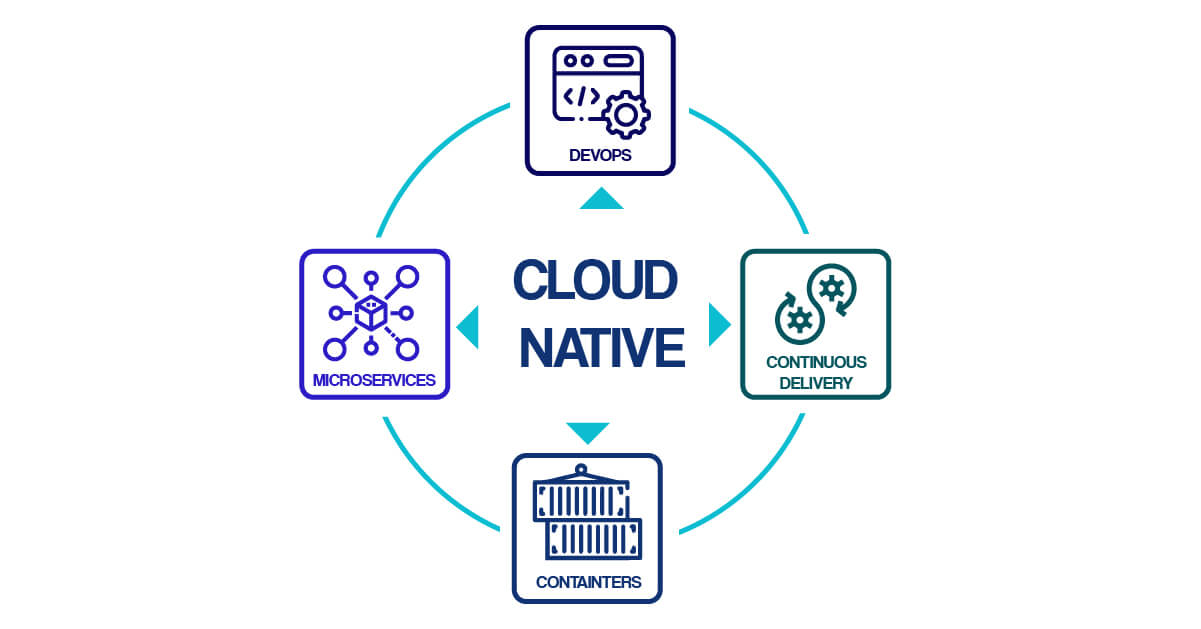Cloud native app development sounds like another IT industry buzzword, but it might just be the breakthrough your organization/business needs to speed up innovation.
The term “cloud native computing” has emerged as a catch-all for the various tools and techniques required by software developers to build, deploy, and maintain modern software applications on cloud infrastructure. The aim of this article is to define the term, survey the cloud native landscape, and identify some of the advantages and drawbacks of choosing cloud native.
To succeed in fast-paced, software-driven markets, companies must change the way they design, build, and use applications.
What is Cloud Native
Cloud native is a modern approach to building and running software applications that exploits the flexibility, scalability, and resilience of cloud computing. Cloud native encompasses the various tools and techniques used by software developers today to build applications for the public cloud, as opposed to traditional architectures suited to an on-premises data center.
The cloud native approach to building and running software was pioneered by a group of companies commonly referred to as “born in the cloud” — such as streaming giants Netflix and Spotify, ride-hailing company Uber, and accommodation booking platform Airbnb. The cloud native approach has since been adopted by other companies looking for similar digital agility and disruptive competitive advantage.
Cloud native technologies empower organizations to build and run scalable applications in modern, dynamic environments such as public, private, and hybrid clouds. Containers, service meshes, micro-services, immutable infrastructure, and declarative APIs exemplify this approach.
These techniques enable loosely coupled systems that are resilient, manageable, and observable. Combined with robust automation, they allow engineers to make high-impact changes frequently and predictably with minimal toil.
Cloud native app development typically includes marrying micro-services, cloud platforms, containers, Kubernetes, immutable infrastructure, declarative APIs, and continuous delivery technology with techniques like devops and agile methodology.
Cloud Native Application & Development
Cloud native application development is an approach to building, running, and improving apps based on well-known techniques and technologies for cloud computing. These applications are a collection of small, independent, and loosely coupled services. They are designed to deliver well-recognised business value, like the ability to rapidly incorporate user feedback for continuous improvement. In short, cloud native app development is a way to speed up how you build new applications, optimize existing ones, and connect them all. Its goal is to deliver apps users want at the pace a business needs.
If an app is “cloud native,” it’s specifically designed to provide a consistent development and automated management experience across private, public, and hybrid clouds. Organizations adopt cloud computing to increase the scalability and availability of apps. These benefits are achieved through self-service and on-demand provisioning of resources, as well as automating the application life cycle from development to production. But to fully utilize these benefits, a new form of application development is needed.
Cloud native development is simply just an approach to building and updating apps quickly, while improving quality and reducing risk. More specifically, it’s a way to build and run responsive, scalable, and fault-tolerant apps anywhere, whether in public, private, or hybrid clouds.

Cloud Native Landscape
There are four layers to cloud native computing that are important to understand:
- Application definition and Development layer: The top layer of the cloud-native stack focuses on the tools used by developers to build applications, such as databases, messaging systems, container images, and continuous integration and continuous delivery (CI/CD) pipelines.
- Provisioning layer: The provisioning layer of the cloud-native stack includes anything required to build and secure the environment where an application will run, ideally in a repeatable fashion. In the cloud-native world, this typically involves treating infrastructure as code, storing images in a repository, automating builds, and addressing application security needs with vulnerability scanning, key and policy management, and authentication tools.
- Runtime layer: The runtime layer concerns anything associated with the running of a cloud-native application, such as the container runtime—which still tends to be Docker—as well as storage and networking.
- Orchestration and Management layer: The orchestration and management layer brings together the tools required to deploy, manage, and scale containerised applications, including orchestration and scheduling. In most cases, that means Kubernetes—as well as service discovery, service proxy, API gateway, and service mesh.
Outside these layers it is also important to implement observability practices, so all these services are monitored effectively. Some organizations also opt to bring their stack together into a self-service internal developer platform or to purchase an opinionated platform as a service (PaaS) from a vendor to ease adoption for developers.

Benefits of Cloud Native
Developing a cloud native application requires knowledge of a certain architecture than most that might work in a traditional on-prem infrastructure. Below are the major/key differences of moving towards a cloud native approach as opposed to the former (traditional application development models)
- Languages: On-premises apps written to run on company servers tend to be written in traditional languages, like C/C++, C#, and enterprise Java. Cloud native apps are more likely to be written in a web-centric language, like HTML, CSS, Java, JavaScript, .NET, Go, Node.js, PHP, Python, and Ruby. Working with modern languages and platforms can help when it comes to attracting the best engineers to work at your organization.
- Updatability: Cloud native apps are built to be highly available, resilient, and regularly updatable, whereas on-premises applications are typically updated once or twice a year using a waterfall methodology. Cloud native computing’s updatability provides a productivity boost for development teams to focus on their competitive advantage and deliver new features to customers more frequently than before.
- Elasticity: Cloud native applications typically take advantage of the elasticity of the cloud by flexing consumption depending on demand, whereas an on-premises application would require the physical provisioning of additional infrastructure to scale effectively. This also has cost implications, as the cloud allows you to pay for what you use and avoid costly over-provisioning of your own infrastructure—at least in theory.
- Multi-tenancy: A cloud native app has no problem working in a virtualized space and sharing resources with other applications using a multi-tenant model. This brings a clear efficiency boost to development teams.
- Downtime: The cloud offers greater redundancy due to the scale and geographical spread of data centers managed by the hyper-scale cloud vendors, so outages can be better managed by quickly redirecting traffic to another region and avoiding costly downtime.
- Automation: Cloud native techniques open up a wealth of automation opportunities for engineers to build once and move on to other more pressing challenges.
- Stateless: Cloud native applications tend to be stateless, in that they don’t carry over saved data from one session to another. This model opens up the opportunity to scale easily across multiple servers, cache more easily for a performance boost, use less storage, and avoid that dreaded vendor lock-in by not being attached to a specific server.
- Community: Thanks to the existence of CNCF (Cloud Native Computing Foundation) which is a open source, vendor-neutral hub of cloud native computing, hosting projects like Kubernetes and Prometheus to make cloud native universal and sustainable, the cloud native community spreads across multiple countries. Due to this, developers/contributors from every part of the world have a reason to work together for a common goal - Making the cloud ubiquitous. As part of the Linux Foundation, the CNCF provides support, oversight and direction for fast-growing, cloud native projects, including Kubernetes, Envoy, and Prometheus.

Drawbacks of Cloud Native
- Trying to lift and shift an existing on-premises application to be cloud native without making architectural changes is a common issue and rearchitecting something for the cloud is also a significant engineering challenge in itself.
- Finding the right skills to do this, adapting to a cloud-centric security model, and managing the changing cost profile of a cloud environment all remain key challenges for organizations looking to go cloud native.
How we can help you
Development teams ought to adopt the principle of cloud native on an organisational level. Whether through migrating existing applications to ones that are cloud native compatible or by ensuring that applications built as monoliths are broken into several microservices that works better in a cloud environment. This will require a significant mindset shift away from traditional waterfall deployments to more agile development principles like minimum viable product (MVP) development, embracing automation, multivariate testing, rapid iteration, observability, and working closely with the operations team in a devops model. This is not an easy shift especially for a team that has been working with the former and that is where our team at Devopsity comes in
- Team: We have a team of Devops engineers that have multiple years of experience in the cloud ecosystem.
- Toolset: All our engineers work with the latest technologies and are also required to take training geared at making them better and up to date with the latest market trends / requirements
- Migration: You probably haven’t moved to the cloud yet because you have several systems running on-premise and not sure how to go about migrating to the cloud. As a company, Devopsity has handled several migration projects. We have a team of certified architects that partakes in planning the migration of your existing apps while having your best interests in mind.
- Support: Migration is just the first step. We can also provide support for your cloud-native applications, thus, taking out the need for you to source your own engineers.
If you have any doubts in mind regarding any of the above or considering going cloud native, you can reach out to us and our team of experts would answer your query.


 Security in cloud native
Security in cloud native
 CNCF landscape
CNCF landscape
 Using ChatGPT for IaC (infrastructure as code)
Using ChatGPT for IaC (infrastructure as code)